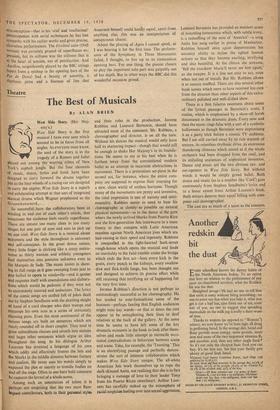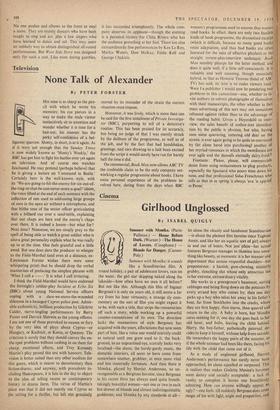Theatre
The Best of Musicals
By ALAN BRIEN West Side Story is the first musical I have ever seen which seemed to be in focus from all angles. As everyone must know, the seed of the story is in the tragedy of a Romeo and Juliet Played out among the warring tribes of New York's asphalt jungle. But the four elements of music, dance, lyrics and book ,have been designed to carry forward the drama together just as the four wheels of a racing car are designed to carry the engine. West Side Story is a superb and exhilarating attempt at that sort of integrated Musical drama which Wagner prophesied as the Gesamikunstwerk, So successful ; have the collaborators been at winding in and out of each other's minds, that sometimes the audience feels nearly superfluous. There are almost too many clues in too many Shapes for one pair of eyes and ears to pick up an one visit. West Side Story is a musical about extroverts and the style throughout is extrovert and self-conscious. In the great dance scenes, every little finger is clicking like a crazy metro- nome as thirty wanton and athletic youngsters hurl themselves into postures unknown even to the Marquis de Sade. The music insists in show- ing its full range as it goes sweeping from jazz to Pop ballad to opera to vaudeville-rand it quotes and requotes itself with emendations and elabora- tions which would be pedantic if they were not so enormously assured and audacious. The lyrics of the comic songs are stuffed full of jokes dealt out by Stephen Sondheim with the dazzling sleight of hand of a card sharper who then trumps and retrumps his own aces in a series of intricately rhyming puns. Even the most sentimental of the serious songs are built on sentences which are rarely rounded off in short couplet. They tend to grow subordinate clauses and stretch into stanzas and beget other sentences which argue an idea throughout the song. In his dialogue Arthur Laurents has invented a language of his own Which oddly and effectively frames the Jets and the Sharks in the middle distance between fantasy and realism. He never uses his words simply to expound the plot or merely to trundle bodies on and off the stage. Often in one bare bald comment he captures the kernel of a whole scene.
Among such an ostentation of talent it is Perhaps not surprising that the two most flam- boyant contributors, both in their personal styles and their roles in the production, Jerome Robbins and Leonard Bernstein, should have attracted most of the comment. Mr. Robbins, a choreographer and director, is on all the time. Without his dances the musical would only have half its shattering impact—though that would still be enough to shake Her Majesty's to its founda- tions. He seems to me at his best when he is farthest away from the conventional modern ballet as an attempt to incarnate abstractions in movement. There is a pretentious set-piece in the second act, for instance, where the entire com- pany are supposed to express their yearning for a new, clean world of endless horizons. Though many of the movements are pretty and inventive, the total impression is one of naivety and senti- mentality. Robbins seems to need to base his choreography as closely, as possible on natural physical movements—as in the dance at the gym where the newly arrived Sharks from Puerto Rico and the first-generation Jets interweave in a mass frenzy as they compete with Latin American mambos against North American jives which are hair-raising in their speed and ingenuity. Robbins is unequalled in the light-hearted back-street rough-house which opens the musical and leads on inevitably to the fatal nimble under the bridge which ends the first act—here every kick in the groin, every punch in the kidneys, every swallow dive and flick-knife lunge, has been thought out and designed to achieve its precise effect while still retaining that terrifying air of happening for the very first time.
Jerome Robbins's direction is not perhaps so outstandingly successful as his choreography. He has tended to over-fantasticate some of the business—perhaps fearing that English audiences might miss key words—so that at times the cast appear to be semaphoring their lines to deaf relatives at the back of the gallery. At the same time he seems to have left some of the key dramatic moments in the book to look after them- selves and made little attempt to reconcile occa- sional contradictions in behaviour between scene and scene. Take, for example, the 'Taunting.' This is an electrifying passage and perfectly demon- strates the sort of intimate collaboration which makes West Side Story unique. The all-white American Jets work themselves up to rape the dark-skinned Anita, not realising that she is in fact bringing a message of love to their leader Tony from his Puerto Rican sweetheart.. Arthur Laur- ents has carefully stoked up the atmosphere of racial suspicion boiling over into sexual aggression. Leonard Bernstein has provided an insistent score of mounting tumescence which, with subtle irony, is a reshuffling of the tune of 'America'—a song Anita has sung earlier in praise of Manhattan. Robbins himself once again demonstrates his uncanny ability to stylise the ugliest human actions so that they become exciting, terrifying and also beautiful. At the climax she screams, 'Tell the murderer Maria'll never see him again,' as she escapes. It is a line not easy to say, even when not out of breath. But Mr. Robbins allows it to remain muffled. There are also several other book scenes which seem to have received less care from the director than other aspects of this extra- ordinary polished and well-drilled show.
There is a thin falsetto sweetness about some of the lyrical passages in Bernstein's score, I realise, which is emphasised by a show-off harsh dissonance in the dramatic duets. Every now and then the music rings false with a sort of a synthetic hollowness as though Bernstein were improvising it as a party trick before a cosmic TV audience. But I am still carried away by its rich warmth of texture, its relentless rhythmic drive, its enormous thundering climaxes which sound as if the whole orchestra had been dropped from the roof, and its unfailing sequences of sophistical invention. Dance and music are the two obvious eye- and ear-openers in West Side Story. But without words it would be ,simply grand ballet. Both dance and music (as in a number like 'Cool') gain enormously from Stephen Sondheim's lyrics and to a lesser extent from Arthur Laurent's book. Both writers deserve their equal billing with com- poser and choreographer.
The cast are as much of a team as the creators. No one pushes and elbows to the front to steal a scene. They are mainly dancers who have been taught to sing and act, plus a few singers who have learned to dance and act. This may seem an unlikely way to obtain distinguished all-round performances. But West Side Story was designed only for such a cast. Like most daring gambles, it has succeeded triumphantly. The whole com- pany deserves its applause—though the evening is a personal victory .for Chita ItNera who has the audience grovelling at her feet. There are also extraordinarily fine performances by Ken Le Roy, Marlys Waters, Don McKay, Eddie Roll and George Chakiris.


























 Previous page
Previous page